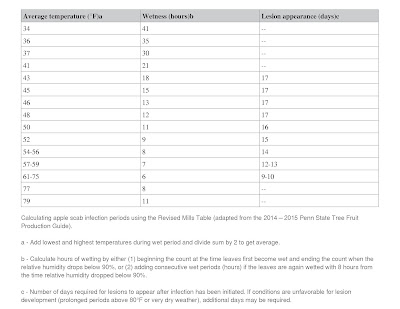 | |
| Infected blooms first appear water soaked and later begin to wilt. |
As we enter into full bloom this week, we have a major pest to consider, and probably the foremost pest at bloom time, fire blight. Fire blight is a serious bacterial disease of apples and pears that is twofold in its development. Fire blight differs from other diseases of apple in that it is caused by bacteria, not fungi. The fire
blight bacteria attacks all tissues of apple tree including blossoms, leaves, shoots,
branches, fruits and even the roots. The bacteria usually
enter the tree through the blooms during bloom time which creates a condition we call blossom blight. Under rainy conditions, the
bacteria then move into the tissues of the flower and on into the rest of the
flower cluster. This infection causes the death of the flowering spur,
which is often the first visible symptom of the disease. As the initial fire blight symptom seen in an orchard, blossom blight
usually indicates where the pathogen first gains its entry into the tree.
The bacteria kill the flower (blossom blight) and sometimes the spur (spur
blight). The damage may resemble frost injury to fruit spurs.
Spur Blight
If fire blight is allowed to become established in the tree, it can rapidly spread from the
current season’s growth into spurs or older growth. Spur blight is the collapse of entire spurs on spur type varieties, after the
initial fire blight symptoms on single flowers. The
bacteria then begins to move inside the plant, killing nearby tissues.
 |
| Note blackened leaves and fruitlets |
So, if the spur on a main branch or the trunk becomes infected, the disease can move from the spur into the trunk or branch eventually developing into a canker which girdles the branch or limb. Death of infected branches is
very rapid and the leaves do not even have time to fall off the tree. The systemically infected shoot has orange-colored leaves at the tip and
is starting to wilt. You can also see wilting leaves around the
infection and the woody stem is also starting to ooze, both above and
below the initial infection. Young,
non-bearing and newly bearing trees can easily be killed by the
infection while mature-bearing trees can usually survive if all the new
growth that is killed is pruned out.
Shoot Blight
As we have seen, fire blight produces several different symptoms depending on the host and site of infection. As the pathogen moves from blossoms it can go to spurs and then shoots. Shoot blight is probably the most well known of all fire blight symptoms. The most commonly observed of these symptom is the characteristic “shepherd’s crook” that develops on wilting twigs, shoots, and leaders. In fact, the name “fire blight” aptly describes the characteristic infections on apple, infected branches turning reddish brown to brown.
 |
| Tips of the shoots have that "shepherd's crook" look to them |
Cankers can then develop, and the margins become raised and blistered, eventually cracking. When the bark is removed, the cankered area may show red-brown streaking. Dead branches scattered throughout the canopy of the tree are common, and trees can die if infections spread into the main stem. The younger the tree, the more likely it will die following infection.
In cases of serious infection, when the bacteria have entered the trunk
of the tree, it’s best to remove the tree entirely, including the stump.
Infected tissue allowed to remain in the planting is a source of
bacteria to infect the rest of your trees. Once the main trunk is
infected, trees cannot be cured of the disease.
Managing Fire Blight
Our
first line of defense against this fire blight bacteria is a copper
based spray at silver tip, before bud break, which we covered in a previous post. To prevent spread after bud break, and to prevent spread, apply a combination of mancozeb and copper to protect new growth. Then at full bloom, a streptomycin spray is necessary using Bonide Fire Blight Spray® or Fertilome Fire Blight Spray®,
which are acceptable for home use. Serenade Garden Defense (Bacillus subtillis) is a biological
control product containing an antibiotic producing bacteria. This
product has been show to reduce infections on apple blossoms if applied
to healthy but at risk blossoms. Any chemical management is not
recommended after petal fall. If you are managing fire blight with
streptomycin, it is essential to reduce the risk of antibiotic
resistance from developing, so do not use streptomycin after any
symptoms may have developed or to control any shoot blight that may
develop. Using streptomycin in those cases is not only ineffective,
but it increases the risk that the bacterium will become resistant to
streptomycin. Once shoot blight has appeared during the growing season, when the weather is dry, prune back about 12
inches below visible symptoms. Remove the prunings from the
yard/orchard and burn them. Between each pruning cut, clean your
pruners by dipping them in a 70% ethyl or isopropyl alcohol solution for
30 seconds or spray pruning shears with Lysol spray to avoid spreading the bacterium.










